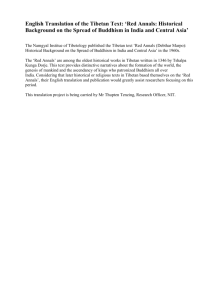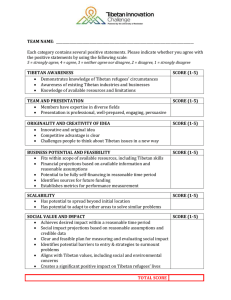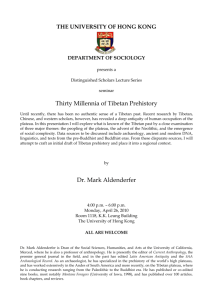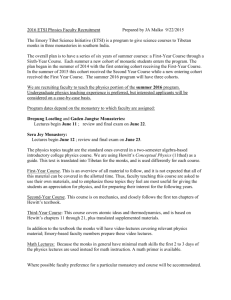Tibetan Architecture: Influences, Structures, and Religious Aspects
advertisement
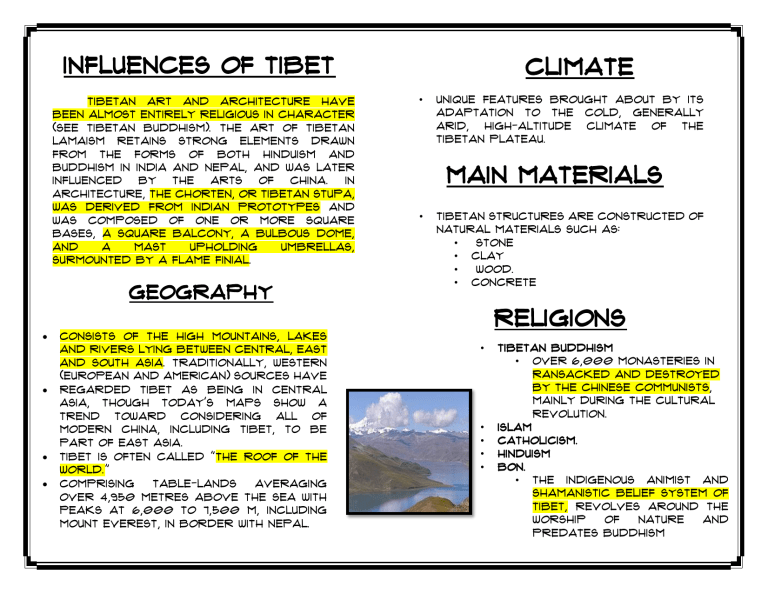
influences of tibet Tibetan art and architecture have been almost entirely religious in character (see Tibetan Buddhism). The art of Tibetan Lamaism retains strong elements drawn from the forms of both Hinduism and Buddhism in India and Nepal, and was later influenced by the arts of China. In architecture, the chorten, or Tibetan stupa, was derived from Indian prototypes and was composed of one or more square bases, a square balcony, a bulbous dome, and a mast upholding umbrellas, surmounted by a flame finial. Geography consists of the high mountains, lakes and rivers lying between Central, East and South Asia. Traditionally, Western (European and American) sources have regarded Tibet as being in Central Asia, though today's maps show a trend toward considering all of modern China, including Tibet, to be part of East Asia. Tibet is often called "the roof of the world." comprising table-lands averaging over 4,950 metres above the sea with peaks at 6,000 to 7,500 m, including Mount Everest, in border with Nepal. Climate • unique features brought about by its adaptation to the cold, generally arid, high-altitude climate of the Tibetan plateau. Main materials • Tibetan structures are constructed of natural materials such as: • Stone • Clay • wood. • concrete religions • • • • • Tibetan Buddhism • over 6,000 monasteries in ransacked and destroyed by the Chinese communists, mainly during the Cultural Revolution. Islam Catholicism. Hinduism bon. • the indigenous animist and shamanistic belief system of Tibet, revolves around the worship of nature and predates Buddhism ; Architectural character Religious structures Two types of religious structure: Temples (GOMPAS) Buildings are generally made from locally available construction materials, and are often embellished with symbols of Tibetan Buddhism. For example, private homes often have Buddhist prayer flags flying from the rooftop The most desirable building sites are on elevated land facing south. Flat roofs are used in most parts of the central and western which experiences rainfall the eastern Tibetan plateau where summer rains are heavier, sloping roofs, covered either in slate, shingles, or (increasingly) ceramic tile, are popular in some regions. Walls that are constructed of stone or rammed earth may be up to a meter thick at the base. In large structures such as temples and manor homes, walls slope inward to create an illusion of greater height. Windows are usually small because the walls are so heavy that large openings would make the structure weak and unstable. In the past, windows featured paper-covered wooden latticework, but nowadays almost universally use glass. used for religious ceremonies and worship; Come in a great variety of styles, generally reflecting local architectural traditions. stupas (Chörtens) are reliquaries and symbols. Chörtens can vary, from roundish walls in Kham to squarish, four-sided walls in Ladakh. In a few regions, especially Danba County, tall and impressive stone towers, many over a century old Ladakh of Jammu Kashmir Gyatse stupa secular structures . houses built in a range of styles and types of secular structure Ganzi is known for its beautiful wooden lavishly private homes multi-family dwellings shops decorated ornamentation. with wooden Although various materials are used in the well-built houses, it is the skillful carpentry that is most striking. Traditional Architecture Farm houses spacious in Kham although the are often first very (ground) floor is usually used to house farm. Traditional Kham architecture is seen in most dwellings in Garzê Tibetan Autonomous habitation. Prefecture. Although the region has been previously heavily logged, wood is columns. County, in In Baiyü turn supported some areas County, and by such Dawu wooden as Dêgê by the increasing use of concrete, County, Sichuan, wood is also used to make log-cabin style exterior walls. room Traditional Tibetan building practices are threatened horizontal timber beams support the roof are and apprentice. forest and used for housing. Throughout the and ceilings, skills are passed down from master to harvested locally from remaining stands of Floors, dividers are made of wood. Carpentry still region, implements and animals, not for human Home interiors are sometimes paneled with wood and cabinetry is ornately decorated. Traditional homes are regarded by some upwardly mobile Tibetans as backward, and towns and cities are increasingly dominated by apartment buildings. Earthquakes are also a threat to traditional Tibetan houses, which often contain insufficient horizontal ties to keep the columns and roof stable during a seismic event Religious Architecture . China's Cultural Revolution resulted in the deterioration or loss of Buddhist monasteries, both by intentional destruction or through lack of protection and maintenance. Starting in the 1980s, Tibetans began to restore or rebuild damaged temples and revive monastic traditions. tashilhunpo monastery Changzhug monastery Jokhang Tsurphu Monastery Tashilhunpo Monastery o shows the influence of Mongol architecture. Changzhug monastery o is one of the oldest in Tibet, said to have been first built in the 7th century during the reign of King Songsten Gampo (605-650 CE). Jokhang o was also originally built under Songsten Gampo. Tsurphu Monastery o was founded by the firstKarmapa, Düsum Khyenpa (1110–1193) in 1159, after he visited the site and laid the foundation for an establishment of a seat there by making offerings to the local protectors, dharmapala and genius loci In 1189 he revisited the site and founded his main seat there. The monastery grew to hold 1000 monks. Tsozong Gongba Monastery o is a small shrine built around 14the century A.D. Palcho Monastery o was founded in 1418 and known for its kumbum which has 108 chapels on its four floors. Chokorgyel Monastery o founded in 1509 by Gendun Gyatso, 2nd Dalai Lama once housed 500 monks but was completely destroyed during the Cultural Revolution. Ramoche Temple o is an important temple in Lhasa. The original building complex was strongly o influenced by Tang Dynasty architectural style as it was first built by Han Chinese architects in the middle of o the 7th century. Princess Wencheng took charge of this project and ordered the temple be erected facing east to show her homesickness. the Kumbum Monastery o continue to be affected by Chinese politics. Simbiling Monastery was completely flattened in 1967, although it has to some degree been restored. Tsozong Gongba Monastery Palcho Monastery chokorgyel Monastery Ramoche temple TECHNIOLOGICAL INSTITUTE OF THE PHILIPPINES 938 AURORA BLDV. CUBAO QUEZON CITY AR333A “tibetan ARCHITECTURE” ASSIGNMENT # 8 RAVENA HARIETTE A. AR31FC1 ARCH. LANCE DOLORES II September 30, 2014 Significance of the Study The importance of this study is to discuss the following information about Tibetan Architecture, It’s infuences,, religion, it’s different kinds of infusion of china , hindu & Buddhist architectural style. It’s to be able to recognize and appreciate it’s antiquity, it’s carefully planned structures. To be able to learn and develop the different techniques in terms in construction in preserving and rebuilding one of the most amazing architecture in ancient history and also To be able to apply it on designing and planning future buildings that are to be erected in the near future. TABLE OF CONTENTS: TITLE: PAGE influences of tibet…………………………….………….……………………..…..…….…1 Architectural character…….…….………………….……………..……………………………….…….…..2 secular structures...….…….……..…………………..……………….……..…………..3 Religious Architecture……………………….……….……………………………..…..………….…..4-5 Bibliography …………………………..…..……………………………………………………6 Bibliography www.wikipedia.org/wiki/Architecture_in_ Tibet

